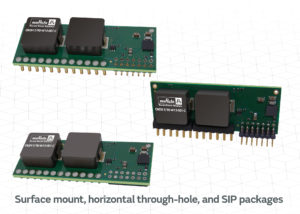 Murata further expands its OKD series of Digital PoL DC-DC converters by launching the 90A/162W OKDx-T/90 series from Murata Power Solutions. This is the highest current-rated product in the OKD series, which already provides solutions from 6A to 60A. The OKDx-T/90 series is ideally suited for FPGA & processor applications. The module is specified to operate over a Vin range of 7.5V to 14V and provides a user-adjustable Vout in the range of 0.6V to 1.8Vdc with industry leading efficiency of 94%. The OKDx-T/90 is available in three different package configurations:
Murata further expands its OKD series of Digital PoL DC-DC converters by launching the 90A/162W OKDx-T/90 series from Murata Power Solutions. This is the highest current-rated product in the OKD series, which already provides solutions from 6A to 60A. The OKDx-T/90 series is ideally suited for FPGA & processor applications. The module is specified to operate over a Vin range of 7.5V to 14V and provides a user-adjustable Vout in the range of 0.6V to 1.8Vdc with industry leading efficiency of 94%. The OKDx-T/90 is available in three different package configurations:
- SIP measuring just 2.0 x 0.37 x 0.75 in (50.8 x 9.51 x19.05 mm),
- Horizontal mounting TH (Through-Hole), and
- SMT versions measuring 2.0 x 0.75 x 0.39 in (50.8 x 19.05 x 10 mm).
The OKDx-T/90 is ideal for space-constrained embedded applications where performance is critical to the application. Critical performance parameters are fully accessible through the PMBus™ via the Murata Power Designer GUI software. The OKDx-T/90-W12 series converters are delivered with a default firmware configuration suitable for a wide operating range in terms of input voltage, output voltage, and loading conditions. The OKDx-T/90 operates over a Vin range from 7.5V to 14V; Vout can be adjusted from 0.6V to 1.8V, with a typical efficiency of 94% with 12Vin, at 1.8V out and 50% load.
The converter’s proprietary digital control power management functions include a range of advanced performance-enhancing features. Its non-linear transient response greatly improves the dynamic response time, reducing Vout deviation due to large load changes; phase spreading reduces input capacitor requirements and efficiency losses. The synchronization feature eliminates beat frequency reflection, resulting in less EMI filtering, and digital current sharing ensures near 100% current sharing accuracy with up to four modules operating in parallel. The converters provide Dynamic Loop Compensation, where the feedback loop parameters are automatically calculated and configured depending on the unique application-specific operating conditions. Additional standard features include output short circuit, over current, over voltage, over temperature, and input under voltage protection. Voltage margining, tracking, power good, remote sense, and remote on/off are also features commonly used in advanced power architectures.
All of the OKDx-T/90-W12’s standard and advanced features can be configured via the Murata Power Designer software (GUI), which includes a high-precision simulation tool.
The converters are suitable for any application requiring high current processor power, particularly in areas such as networking, computing/servers, telecom, powering FPGAs, CPUs, programmable logic, mixed voltage systems, advanced computing, and all distributed power applications.


Leave a Reply